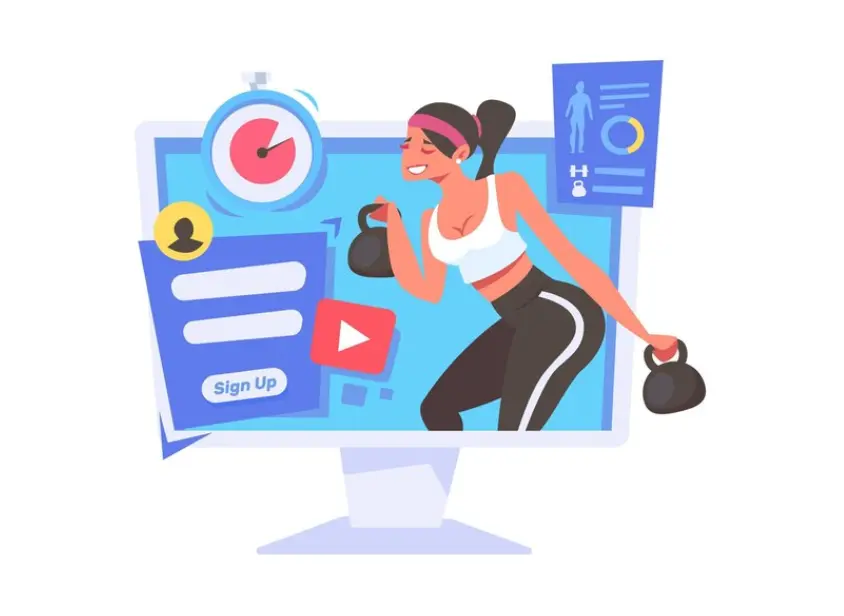Hey, fitness enthusiasts and wellness warriors! So, you’ve been pouring your heart and soul into your fitness website, sharing workout tips, nutrition advice, and the occasional sweaty selfie. But what if I told you that you could turn those lunges into dollars and those push-ups into profit?
Monetizing a fitness website isn’t just about turning a hobby into a paycheck; it’s a strategic move that can bring about several benefits for both the website owner and their audience. Let’s dig in.
Table of Contents
How to Monetize a Fitness Website
Monetizing a fitness website or app is a pivotal strategy for sustaining growth and ensuring the continuous delivery of valuable content or products to the audience.

Here are several common monetization methods for a fitness website, viewed from the perspective of a website publisher:
- Advertising: Incorporating various types of advertising on the website, such as display ads, banner ads, or native advertisements. These ads can be sourced through ad networks like Google AdSense or direct partnerships with brands relevant to fitness, generating revenue based on clicks, impressions, or actions.
- Affiliate Marketing: Enter the affiliate marketing world, where shrewd publishers can earn a commission for promoting products and services through personalized links. From workout equipment to supplements and fitness programs, there are plenty of opportunities in this field for fitness enthusiasts to turn their passion into profit.
- Sponsored Content: Partnering with brands to create sponsored posts, articles, or videos that integrate their products or services. This method involves receiving compensation for featuring or reviewing the sponsor’s offerings within the website’s content.
- Digital Products: Developing and selling digital products tailored to the fitness niche. These could include workout plans, e-books, instructional videos, or subscription-based access to exclusive content, providing an additional revenue stream.
- Physical Products: One way to boost profits on your website is by selling physical products that cater to fitness enthusiasts. This can include a range of items such as workout gear, apparel, supplements, and merchandise adorned with your brand’s logo or catchy slogans.
- Online Courses or Memberships: Offering premium content, specialized courses, or exclusive membership programs with access to in-depth fitness training, personalized coaching, or community forums. Subscribers pay a recurring fee or a one-time purchase to access these resources.
Today, we’re diving into the interactive realm of digital advertising — a landscape where your fitness website meets monetization in exciting ways.
Understanding Ad Monetization:
Ad monetization refers to the income earned by displaying advertisements on websites or platforms. For fitness publishers, this opens up an exciting opportunity to not only share their health and wellness journey but also create a sustainable income stream.
1. The power of programmatic advertising:
Programmatic advertising is the automated process of buying and serving ads. It means that using real-time data and automated technologies, targeted ads are being served to the users.
Programmatic ads are the bread and butter of many fitness publishers’ monetization strategies. Strategically placed on your website, these visual advertisements offer a steady revenue stream.
From workout gear to nutritional supplements, display ads connect your audience with products and services relevant to their fitness journey. Advertisers are also willing to pay higher eCPM for your ad inventories. Banner ads, video ads, native ads, and rich media ads are something you must try.
2. Choosing the right partner:
Ad monetization is a difficult realm to be ruled. You must have the best of traffic, website, monetization partners, technologies, and demand partners (advertisers) to have a competitive edge.
Honestly, almost all of the above can be sorted by partnering with a good monetization partner. Partners like Automatad not only bring the best of the ad tech technologies, solutions, and partnerships with premium demand sources (including ad networks and ad exchanges) but also take care of your website health score.
3. Serve relevant ads
Fitness is a diverse field, and your website content or products likely cater to a specific niche—whether it’s weightlifting, yoga, or nutritional guidance. Serve ads that align with your niche to ensure relevance and resonance with your audience. The more closely the ads match your content, the more engaged your readers will be.
4. Seamless integration for user experience:
One of the challenges of incorporating ads is maintaining a positive user experience. Ensure your display ads seamlessly integrate with your website’s design and layout. Strategic placement, such as at the top of the content, within the content, at the bottom, or beside the post, can maximize visibility without disrupting the flow.
5. Exploring video ads for dynamic engagement:
In the fitness realm, where visual content is paramount, video ads can be a game-changer. Many fitness enthusiasts turn to video content for workout demonstrations and health tips. Incorporating video ads into your website allows for dynamic engagement and opens up additional revenue streams.
6. Maximizing affiliate marketing opportunities:
Affiliate marketing is an essential source of ad revenue for fitness publishers. Partnering with brands and promoting their products through affiliate links can be a lucrative addition to your overall monetization strategy.
7. Diversifying income streams:
Ad revenues are just one stream of income. To fortify your financial foundation, consider diversifying with sponsored content, online courses, or even merchandise. Multiple income streams ensure stability and flexibility as you navigate the ever-evolving landscape of fitness blogging.
8. Staying true to your fitness narrative:
Amidst the revenue-generating hustle, always stay true to your fitness narrative. Your authenticity and passion are what drew your audience in the first place. Ad revenues should enhance, not compromise, the value you provide to your readers on their fitness journey.
Pros and Cons of Using Ads for Monetizing
At the risk of stating the obvious, here are certain pros and cons you must consider:
Pros:
- Passive income: Ads can generate passive income for the website publisher. Once the ads are set up, revenue can be earned based on clicks, impressions, or actions without requiring constant active involvement.
- Diversified revenue: By implementing ads, businesses can diversify their sources of income, reducing their dependence on a single revenue stream. This diversification ultimately leads to more stability, particularly when used in conjunction with other monetization methods.
- Effortless integration: With the simple setup process of ad tech platforms, publishers can seamlessly incorporate ads into their website’s layout to begin generating revenue swiftly.
Cons:
- User experience impact: The user experience can be significantly affected by excessive or intrusive advertisements. This can result in slower page loading speeds, a cluttered and unappealing appearance, and ultimately, could frustrate and drive away potential audience members from the website.
- Revenue dependency: Revenue from advertising can be highly erratic, relying on multiple factors such as the volume of website visitors, where ads are placed, and how engaged users are. Slight shifts in algorithms, advertising guidelines, or market conditions can have a substantial impact on earnings.
- Limited control over ad content: Publishers may not always have complete control over the advertisements shown on their website. This can lead to the presence of unsuitable or unrelated ads, which could damage the website’s reputation and disconnect with its audience.
- Cannibalization of traffic: Clicking on ads might divert visitors away from the website, reducing engagement with the site’s original content. This can impact the time users spend on the site and potentially lower the chances of converting them into customers for other products or services.
- Minimum traffic requirements: Some premium ad networks or higher-paying advertisers may require a minimum level of traffic or audience reach before allowing participation, limiting opportunities for smaller or newer websites to access lucrative ad deals.
To Do or Not to Do
In the dynamic world of fitness, monetization is the key to transforming your passion into a sustainable success story. Ad revenues, particularly through programmatic display ads, offer a reliable income stream and enhanced user engagement.
Yet, it’s essential to strike a balance, considering both the advantages and potential pitfalls. As you continue sculpting your fitness website, stay true to your narrative and authenticity. Each drop of sweat has the potential to symbolize success in a landscape where your dedication and passion resonate with a growing audience. So, keep inspiring, evolving, and monetizing your fitness website with a purpose.























